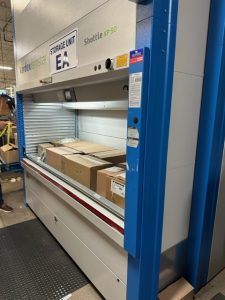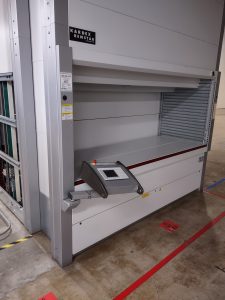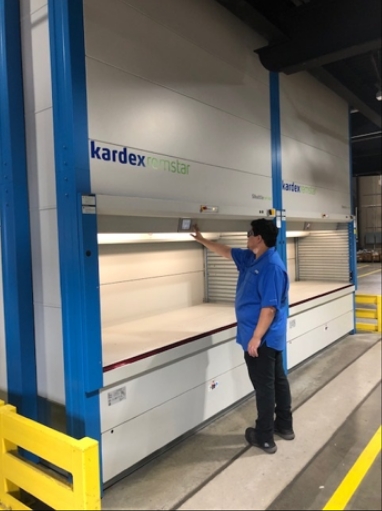In the world of warehousing and logistics, efficiency is key. One technology that’s revolutionizing these sectors is the Vertical Lift Module (VLM), often referred to as a VLM machine in the industry.
But what is a VLM exactly? It’s an automated storage and retrieval system that optimizes vertical space. It’s an automated storage and retrieval system that optimizes vertical space. It’s a game-changer for inventory management and control.
VLMs are gaining popularity across industries for their ability to streamline operations. Whether you’re running a tight urban warehouse or a high-volume distribution center, a VLM can dramatically improve workflow.
Vertical Lift Modules and VLM storage systems offer numerous benefits. They save space, improve productivity, and enhance ergonomics for staff. They’re also scalable and customizable, making them a versatile solution for various industries.
In this article, we’ll delve into the definition and applications of Vertical Lift Modules. We’ll explore how they work, their components, and their role in modern warehousing.
Whether you’re a warehouse manager, a logistics professional, or simply curious about this technology, this comprehensive guide will help you understand what a Vertical Lift Module is and how it can transform operations.
What is a Vertical Lift Module (VLM)?
If you’ve ever asked yourself what is a Vertical Lift Module and how it works, this section breaks it down.
VLMs, also known as vertical lift parts management systems, optimize the use of vertical space. This system comprises stacks of trays that move up and down between two towering columns.
Each VLM, functioning as a vertical lift parts management system, contains a central extractor device. This inserter/extractor mechanism retrieves and delivers the trays automatically, minimizing human effort and error.
A VLM machine, another common name for a Vertical Lift Module, is a computer-controlled automated storage and retrieval system that stores items in vertically arranged trays and delivers them to an operator automatically. In industry language, “VLM machine” and “Vertical Lift Module” refer to the same technology: a high-density vertical storage system designed to save floor space, improve picking accuracy, and streamline inventory management.
Vertical Lift Modules are controlled by sophisticated software. The software facilitates precise inventory management and smooth integration with existing systems.
Warehouses can realize significant space savings with VLMs. By consolidating storage vertically, they reduce the need for vast floor space.
Additionally, VLMs enhance operational efficiency. They streamline retrieval processes, boost picking accuracy, and reduce employee strain.
These systems cater to a range of industries. From automotive to pharmaceuticals, VLMs are making a notable impact across supply chains.
Overall, implementing Vertical Lift Modules can revolutionize warehouse and storage operations. They provide a modern, efficient solution adaptable to diverse needs.
The Evolution and Components of VLMs
The Vertical Lift Module (VLM) has evolved significantly over the years. Initially, storage solutions required vast space and considerable manual effort. The emergence of Vertical Lift Module technology changed this landscape. Vertical Lift Modules have transformed from basic mechanisms to highly sophisticated systems.
Modern Vertical Lift Modules incorporate cutting-edge technology. They employ advanced software and control systems, promoting seamless inventory management. This evolution enables improved accuracy and efficiency, vital in fast-paced industries.
Moreover, Vertical Lift Modules now integrate with broader warehouse management systems (WMS). This integration allows for automated data flow, enhancing overall operational control. Over time, VLMs have become more flexible. They adapt to varying business requirements and are tailored to industry-specific needs.
As Vertical Lift Modules continue to advance, the focus remains on innovation. Technological improvements offer promising prospects for further enhancements. These developments underline the critical role of VLMs in modern logistics and storage management.
If you are interested in learning more into the history of VLMs, check out this article.
Key Components of a VLM System
A Vertical Lift Module (VLM storage system) comprises several crucial components. At its core are the trays, stored vertically and moved via an automated system.
The extractor device is pivotal to Vertical Lift Module operation. It retrieves and delivers these trays efficiently, minimizing manual intervention.
An integral computerized control system manages the entire process. This system ensures precise operations and seamless integration with warehouse software.
In industrial environments, VLM machines come in several configurations depending on throughput and space requirements. The most common types include internal-bay VLMs (ideal for tight footprints), external-bay VLMs (for faster picking and batch processing), single-column or narrow-profile VLMs (for small parts or height-restricted areas), dual-column VLMs (the highest-density and most widely used design), heavy-duty VLMs (for oversized or high-weight items), and temperature-controlled or clean-room VLMs for regulated industries like pharmaceuticals and electronics.
How VLMs Optimize Warehouse Space and Operations
VLM storage systems play a crucial role in optimizing warehouse space. They utilize the vertical dimension, turning unused overhead space into productive storage. This optimization is vital in settings where floor space is limited or expensive.
Efficiency in warehouse operations is significantly enhanced once you understand what a Vertical Lift Module does and how it optimizes workflows.. They streamline the retrieval process, reducing the time needed to pick items. Automation minimizes errors, providing a consistent workflow and improving task precision.
Vertical Lift Modules also enhance flexibility in storage management. They accommodate various sizes of goods within the same system. This adaptability makes them suitable for diverse inventory needs across industries.
Furthermore, Vertical Lift Module systems can be easily integrated with existing warehouse technologies. This integration ensures a smooth, cohesive operation, boosting overall productivity. By automating routine tasks, VLMs free up staff to focus on more strategic activities.
Overall, Vertical Lift Modules contribute to a more organized and efficient storage environment. Their innovative design supports modern businesses striving to maintain competitive advantages.
Space Savings and Reduced Footprint
VLMs dramatically reduce the need for vast warehouse spaces. By utilizing vertical areas, they increase storage capacity per square meter, making them a powerful tool for high density warehouse storage.
The space-saving potential of VLMs is particularly beneficial in urban areas. Here, real estate prices can be prohibitively high, making efficient storage solutions essential. Compact VLM systems allow businesses to thrive even in space-constrained environments. Many companies exploring what is a Vertical Lift Module discover its main benefit is maximizing vertical storage without costly expansion.
Additionally, VLMs contribute to leaner operations. They reduce the clutter typically associated with traditional storage methods. This streamlined setup facilitates better movement and enhances workplace safety.
Improved Inventory Management
Effective inventory control is vital for any vertical lift parts management system. VLMs excel in this area by providing precise control over stock levels. Automated inventory checks ensure items are correctly logged and accounted for.
The incorporation of digital monitoring systems in VLMs offers real-time inventory visibility. This transparency helps in planning and decision-making, supporting just-in-time inventory practices. Businesses can thus reduce surplus stock and improve cash flow. When understanding what a Vertical Lift Module can do for inventory control, it’s clear that automation leads to greater accuracy and transparency.
Moreover, VLMs contribute to accurate order fulfillment. They minimize human error in picking, leading to higher customer satisfaction. The precision of VLM technology aligns with modern expectations for quick, reliable service delivery.
Learn about automated storage systems for better inventory control.
Why a VLM Could be the Best System for Your Warehouse
Implementing a VLM storage or vertical lift parts management system offers numerous benefits. Among these, enhancing operational efficiency stands out. VLMs streamline storage and retrieval processes, reducing time and minimizing errors.
Moreover, Vertical Lift Module systems contribute significantly to space optimization. They help warehouses and facilities make the most of their available vertical space. This leads to reduced footprint and potential cost savings on storage space.
The improved accuracy in inventory management is another key advantage. VLMs ensure that items are stored and retrieved correctly. This accurate handling increases order fulfillment reliability, which is crucial for customer satisfaction.
In addition to operational benefits, VLMs also enhance safety. Automated systems reduce the need for manual handling, decreasing the risk of injuries. Safety features integrated into VLMs further protect workers.
These advantages answer not just what is a Vertical Lift Module, but also why it’s becoming essential for modern operations.
Investing in used vertical lift modules can also yield many of the same benefits with a lower upfront cost, offering a strong ROI.
Efficiency and Productivity Gains
Efficiency and productivity see a marked improvement with VLMs. By automating storage tasks, they cut down on the time spent searching for items. Automation leads to faster retrieval, expediting overall warehouse operations.
VLM storage systems also improve productivity by ensuring precise and accurate handling.. This reduced error rate minimizes the need for costly corrections. Over time, these savings accumulate, supporting higher operational efficiency.
Additionally, VLM systems facilitate better workflow management. The automated process smooths out bottlenecks in order fulfillment. As a result, businesses experience enhanced throughput and increased output capacity.
Ergonomic Advantages for Staff
Vertical Lift Modules bring considerable ergonomic benefits to workplaces. They reduce the need for physical bending and stretching, which can cause strain. By automatically adjusting to the operator’s level, VLMs promote a safer working posture.
These systems significantly lower the risk of injury-related downtime. Automation decreases manual handling, creating a safer work environment for staff. Fewer physical demands mean employees can work more comfortably and efficiently.
Moreover, Vertical Lift Modules contribute to a better work environment by lessening fatigue. Staff can maintain productivity without the physical wear typically associated with manual storage tasks. This improved ergonomics not only boosts morale but also enhances job satisfaction.
VLMs in Different Industries: Applications and Case Studies
Vertical Lift Modules (VLMs) have transformed operations across various industries. Their applications extend far beyond traditional storage solutions, catering to diverse needs. Manufacturing, for instance, greatly benefits from VLMs for efficient parts storage and retrieval.
In the automotive industry, VLMs streamline inventory management. They enable quick access to tools and spare parts, reducing downtime. This efficiency helps maintain continuous production, crucial in car manufacturing.
The pharmaceutical sector also leverages VLMs for controlled inventory environments. These modules ensure the safe and organized storage of sensitive materials. This environment safeguards product integrity and complies with regulations.
Retailers use VLMs to enhance their omnichannel fulfillment strategies. The ability to process orders swiftly is vital in today’s consumer-driven market. VLMs play a critical role in meeting customer demands for fast delivery.
Case studies highlight successful Vertical Lift Module implementations in these sectors. Many companies have seen enhanced workflow and significant cost savings. Such testimonials underscore the strategic advantage VLMs provide.
Explore VLM applications in industries like automotive, healthcare, and manufacturing.
Some operations pair VLMs with mobile aisle storage systems for even greater space utilization and flexibility.
Industry-Specific Customization and Integration
VLM storage systems offer industry-specific customization options. This adaptability meets the unique requirements of different sectors. Custom solutions ensure VLMs align perfectly with operational goals.
Integrating Vertical Lift Modules with existing systems is seamless. Many businesses connect them to their Warehouse Management Systems (WMS) and Enterprise Resource Planning (ERP). Such integration boosts data accuracy and operational cohesion.
In addition, Vertical Lift Modules can align with regulatory compliance needs. Industries like healthcare rely on tailored solutions to meet stringent guidelines. This capability ensures that VLMs support effective and compliant storage strategies.
Choosing the Right VLM for Your Business
Selecting a VLM demands careful evaluation of your needs. Understand your warehouse capacity and storage demands first. This assessment ensures a compatible VLM solution.
Consider your existing processes and workflow integration. Aligning a VLM with your current operations reduces disruption. This step enhances efficiency and supports seamless adoption.
Consulting with a VLM expert can be insightful. Their experience helps tailor the VLM to your specific requirements. Professional guidance ensures a smooth transition and effective implementation.
Factors to Consider and ROI
When choosing a VLM, several factors must be assessed. Start with the available space and the VLM’s vertical capabilities. This evaluation ensures optimal storage utilization.
Consider the technology and scalability of the Vertical Lift Module. Future expansion demands a system that grows with your business needs. This foresight supports long-term benefits and adaptability.
Analyze the potential return on investment (ROI). Improved productivity, reduced labor costs, and space savings contribute to a sound ROI. A strategic investment in a VLM boosts overall business performance.
The Future of VLMs: Trends and Advancements
The future of Vertical Lift Modules is promising. Advancements in technology continually enhance their efficiency. These innovations keep VLMs relevant in modern logistics.
Integration with automation systems is a key trend. VLMs are increasingly interacting with other smart technologies. This interaction optimizes warehouse operations seamlessly.
Sustainability is also a focus. Energy-efficient Vertical Lift Module designs reduce power consumption. This shift aligns with global moves toward greener business practices.
Integration with Robotics and AI
VLMs are evolving with robotics in mind. Robots can manage VLM operations, reducing human intervention. This transition boosts accuracy and operational speed.
Artificial Intelligence (AI) further refines VLM functionality. AI can predict demand and optimize storage layouts. Such features enhance inventory management effectiveness.
These advancements improve competitive positioning. Businesses adopting VLMs with AI and robotics gain an edge. Such integration transforms traditional storage into smart, dynamic systems.
Conclusion: The Role of VLMs in Modern Warehousing
Vertical Lift Modules revolutionize storage solutions. They improve efficiency and optimize space utilization. As technology advances, their impact grows.
So, what is a Vertical Lift Module in today’s logistics world? It’s a powerful tool reshaping how companies store, access, and manage inventory.
Interested in implementing a VLM at your facility? Contact us today for a free space analysis and see how a custom VLM solution can improve your operations.




